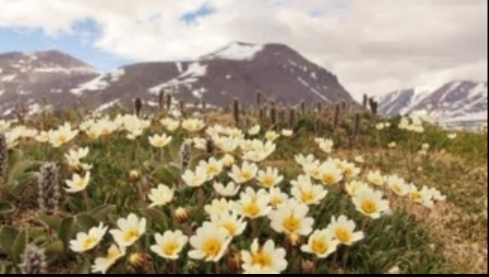
北极传粉昆虫前途未卜
Arctic Pollinator Faces Uncertain Future
北极传粉昆虫前途未卜
A housefly relative appears to be key to the reproductive success of a hardy tundra shrub. But the insect is threatened by the warming climate. Christopher Intagliata reports.
一种家蝇的亲戚似乎是耐寒苔原灌木繁殖成功的关键。但据克里斯托弗·因塔利亚塔(Christopher Intagliata)报道,这种昆虫正在受气候变暖的威胁。
播音\撰文:克里斯托弗·因塔利亚塔(Christopher Intagliata)。
翻译:杨枭
审校:丁可含
The Greenland High Arctic is a bare, sparse place. Rather than tall trees, it has tundra—ground hugging vegetation—and rugged, Lord-of-the-Rings-style vistas. "Well I don't know, it's not exactly New Zealand, but kind of similar landscape."
格陵兰北极地是片荒芜的地方,那里没有高树只有地毯似的的苔原,很像《魔戒》中的景色。“呃,我不知道,尽管它确实不是新西兰,却有着相似的地貌风景。”
Mikko Tiusanen, an ecologist at Helsinki University in Finland. "The winter season is like six, seven months. So everything basically happens during the short summer season." Including the white-yellow bloom of mountain avens, a hardy arctic shrub. "Even though it's small it can be over 100 yrs old. It's pretty good at surviving harsh conditions."
米科·蒂乌萨宁(Mikko Tiusanen)是芬兰赫尔辛基的一名生态学家。“冬季持续六七个月,因此万物只有短短的夏季可以复苏。”这包括一种北极灌木植物仙女木,它会开出黄白色的花朵。“即使它很小,它却可以活过100年。能够在如此恶劣的环境下生存实在是太了不起了。”
Tiusanen and his colleagues set out to census which of the many local insects visit mountain avens by summer, and help with pollination. So they planted 2100 sticky flower lookalikes, as traps, and identified stuck visitors by their DNA.
蒂乌萨宁和同事着手统计了哪些当地昆虫会到夏天帮助山仙女木传粉。为此,他们种植了2100株相似的热湿性植物做陷阱,并通过DNA来确认被困住的昆虫。
Two-thirds of all local insect species visited. But it was one particular fly, a relative of the humble housefly, that showed up most often in those spots where the tundra shrubs had successfully set seed. Meaning more flies appeared to be a good thing for the avens. The study appears in the Proceedings of the Royal Society: B. [Mikko Tiusanen et al, One fly to rule them all—muscid flies are the key pollinators in the Arctic]
这些植株吸引了三分之二的当地昆虫物种。但是只有一种家蝇的近亲脱颖而出,在苔原灌木成功结籽的位置出现得最频繁。由此可见,更多的飞蝇似乎更有利于山仙女木生存。这项研究发表在了《皇家学会学报》上。
Here's the bad news: a 2013 study found that the Arctic flowering season is shortening. The numbers of fly pollinators is down, as is the the number of visits by these fly pollinators. Which could be bad for mountain avens—and beyond. "One could expect that also the other pollinators and flower visitors visiting the mountain avens could get more uncommon and even become extinct in the long run." Meaning "shoo fly" could spell trouble for the life of the tundra.
坏消息是:一项2013年的研究发现北极的花期正在缩短。传粉苍蝇的数量正在下降,它们与山仙女木的接触也随之减少。这可能对山仙女木不利。此外,“由此推知其他授粉昆虫也越来越少见甚至灭绝。”那意味着,这些消逝的飞虫可能会为冻原的生命带来麻烦。
未经书面许可任何人不得复制或镜像
京ICP备11000850号-1
 京公网安备11010502039775号
京公网安备11010502039775号 信息网络传播视听节目许可证0111611号
国家科技基础条件平台

















